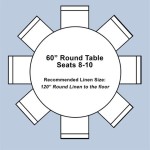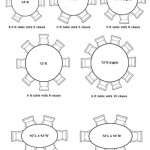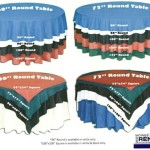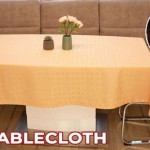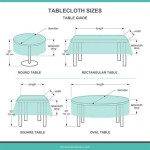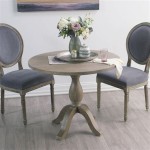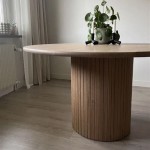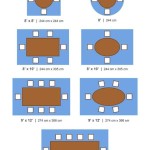What Size Table Runner for a 60-Inch Round Table?
Determining the appropriate size of a table runner for a 60-inch round table is a crucial step in achieving both aesthetic balance and functional elegance. The table runner serves not only as a decorative element but also as a protective layer for the table surface. Choosing the right size ensures that the runner complements the table's shape and size, enhances the overall decor, and provides adequate coverage where needed. Several factors influence the ideal runner length, including desired overhang, the table's use, and personal preferences.
Before delving into specific measurements, it is essential to understand the basic principles of table runner placement. Generally, a table runner should extend beyond the edge of the table, creating an overhang. This overhang not only adds visual appeal but also helps to prevent the runner from shifting or sliding. The amount of overhang is a matter of personal taste and the desired formality of the setting. A longer overhang typically conveys a more formal and elegant ambiance, while a shorter overhang can offer a more casual and contemporary feel. Therefore, understanding the intended purpose of the table and the desired aesthetic is crucial in determining the appropriate runner size.
The shape of the table also dictates the considerations for the table runner. Round tables present a unique set of factors compared to rectangular or square tables because the runner should visually bisect or complement the circular form. The curvature of the table's edge affects how the runner drapes and how much of the table surface remains exposed. These factors must be considered to achieve a balanced and visually appealing result.
Understanding Ideal Overhang and Runner Placement
The most critical aspect of selecting a table runner size is determining the desired overhang. Overhang refers to the length of the runner that extends beyond the edge of the table. For a 60-inch round table, a common recommendation is to aim for an overhang of between 6 to 12 inches on each end of the runner. This means that the total length of the runner should be the diameter of the table plus twice the desired overhang amount. For instance, if a 6-inch overhang is desired on each end, the calculation would be 60 inches (table diameter) + 6 inches (overhang) + 6 inches (overhang) = 72 inches. This would suggest a 72-inch runner as a minimum length.
Conversely, if a 12-inch overhang is preferred for a more dramatic and formal look, the calculation would be 60 inches (table diameter) + 12 inches (overhang) + 12 inches (overhang) = 84 inches. This would indicate that an 84-inch runner would be suitable. These calculations provide a foundational guideline but can be adjusted based on specific design elements or personal preferences. It is also worth considering that runners come in standard sizes, such as 72 inches, 90 inches, or 108 inches, so selecting the closest available size while remaining within the desired overhang parameters is often necessary.
Another important consideration in runner placement is the width of the runner. While the length is determined by the overhang, the width should be proportionate to the table's diameter to avoid looking too narrow or too wide. A general guideline for a 60-inch round table is that the runner should be approximately one-third to one-half of the table's diameter. Therefore, a runner width of 20 to 30 inches is usually appropriate. This width allows the runner to cover a substantial portion of the table's center while still showcasing the table's surface on either side. It is also crucial to consider the location of other table settings, such as placemats or centerpieces. If these items will be placed on top of the runner, the width may need to be adjusted to accommodate them without overcrowding the table.
Furthermore, the proper placement of the runner is not merely about length and width but also about ensuring that it is centered correctly on the table. An off-center runner can disrupt the visual balance and detract from the overall aesthetic. Taking the time to measure and adjust the runner until it is perfectly centered is essential for achieving the desired look. A visual check from multiple angles can help ensure that the runner is aligned correctly and that the overhang is consistent on both ends.
Considering Table Use and Occasion
The intended use of the table plays a significant role in determining the most suitable table runner size. For everyday use, a shorter overhang may be more practical. A runner with a 6-inch overhang, resulting in a total runner length of 72 inches for a 60-inch round table, can offer a clean and functional look without being overly formal. This size is less likely to interfere with daily activities, such as serving meals or using the table for work. It is also easier to clean and maintain since there is less fabric extending beyond the table's edge.
In contrast, for special occasions or formal gatherings, a longer overhang can enhance the table's elegance and create a more sophisticated ambiance. An 84-inch runner with a 12-inch overhang provides a more dramatic and visually appealing effect. This is particularly suitable for events such as dinner parties, holiday celebrations, or weddings. The longer overhang adds a touch of luxury and helps to elevate the overall table setting. However, it is important to ensure that the longer overhang does not pose a tripping hazard or obstruct the movement of guests around the table.
The type of meal being served and the serving style should also influence the runner size. For example, if the table is primarily used for buffet-style meals, a wider runner may be preferable to protect the table surface from spills and stains. A runner that covers a larger portion of the table can also serve as a convenient platform for serving dishes and utensils. Conversely, if the table is primarily used for plated meals, a narrower runner that complements the place settings may be more appropriate. The goal is to strike a balance between functionality and aesthetics, ensuring that the runner both protects the table and enhances the overall dining experience.
Additionally, the presence of a tablecloth should be taken into account. If the table is already covered with a tablecloth, the table runner serves primarily as a decorative accent. In this case, the runner size can be chosen based on purely aesthetic considerations, such as color, pattern, and texture. A slightly shorter runner with a minimal overhang may be preferable to avoid overwhelming the table with too much fabric. Conversely, if the table is bare, the runner plays a more significant role in protecting the table surface and adding visual interest. In this scenario, a slightly longer runner with a more substantial overhang may be desired to provide adequate coverage and create a focal point.
Aesthetic Considerations and Personal Preferences
Ultimately, the choice of table runner size is a matter of personal preference and aesthetic considerations. While the guidelines mentioned above provide a useful starting point, the final decision should be based on the individual's taste and the overall design scheme of the room. Factors such as the color, pattern, and texture of the runner can influence how it interacts with the table and the surrounding decor.
For example, a brightly colored or patterned runner can serve as a focal point, drawing attention to the table and adding visual interest to the room. In this case, a slightly shorter runner may be preferred to allow the pattern to be fully appreciated without being obscured by excessive overhang. Conversely, a runner with a subtle color or texture may blend more seamlessly with the table and the surrounding decor. In this scenario, a slightly longer runner may be desired to add a touch of elegance and sophistication.
The style of the table and the overall design of the room should also be taken into account. A modern or minimalist room may benefit from a shorter runner with clean lines and a simple design. A more traditional or formal room may be better suited to a longer runner with intricate details and a luxurious fabric. The goal is to create a cohesive and harmonious look that reflects the individual's personal style and the overall ambiance of the space.
Furthermore, the presence of other decorative elements on the table should be considered when choosing the table runner size. If the table will feature a large centerpiece, a smaller runner may be preferable to avoid overcrowding the space. Conversely, if the table will be sparsely decorated, a larger runner can help to fill the visual void and create a more balanced and inviting look. Experimenting with different runner sizes and placements can help to determine which option best complements the other decorative elements on the table.
In conclusion, selecting the right table runner size for a 60-inch round table involves a combination of practical considerations and personal preferences. Understanding the principles of overhang, considering the intended use of the table, and taking into account aesthetic factors are all essential steps in achieving the desired result. By carefully evaluating these factors, individuals can choose a table runner that not only protects the table surface but also enhances the overall beauty and ambiance of the space.

What Size Table Runner Should You Use On Your See A Standard 108 X14 Looks L Round Tablecloth Sizes Wedding Linens

Table Cloth And Runner Sizing Chart

Table Runners For Round Tables Find The Right Runner

Table Runners For Round Tables Find The Right Runner

Hiasan Checd Round Tablecloth 60 Inch Waterproof Wrinkle Resistant Washable Fabric Spring Table Cloth For Dining Room Party Outdoor Picnic Yellow And White Com

Table Runners For Round Tables Find The Right Runner

Linen Size Chart Wedding Table Linens Settings Party Cloth

3 Ways To Choose A Tablecloth Size Wikihow Life

The Best Round Table Runner Ideas Arinsolangeathome

Tablecloth Size Chart
Related Posts

